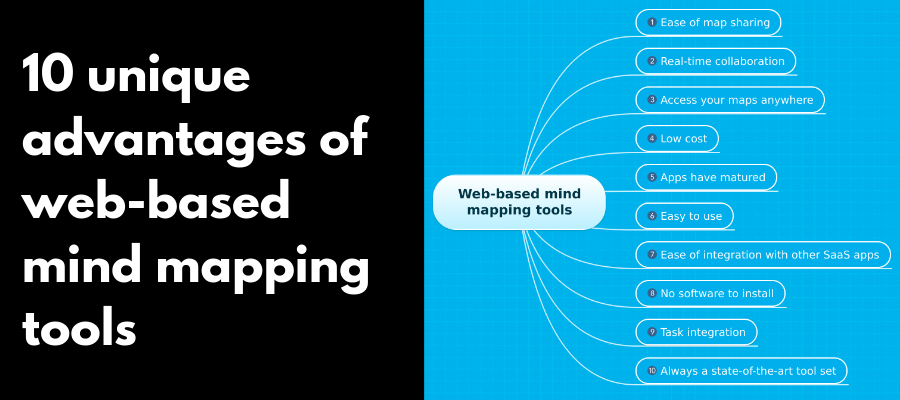If you’re looking for a low-cost way to try out mind mapping for business, then a web-based tool is a great place to start.
Thanks to the recent advent of HTML 5 technology, today’s web-based mind mapping apps are well-designed and easy to use. Some of these tools now have almost as much functionality as their desktop counterparts. A big factor if you’re just starting out with mind mapping is cost: these programs are available at a fraction of the cost of desktop software.
Here are 10 unique advantages that web-based mind mapping tools offer compared to their traditional desktop counterparts:
1. Access your mind maps anywhere: When you create mind maps using a web-based application, they are stored online. That means you can access them from any computing device you use – including tablets and smartphones. The leading developers in this space have added support for a full range of mobile devices, making it easy to view, edit and create mind maps no matter where you are.
Like other web-based applications, you can start developing a mind map on your iPhone as you’re sitting in your easy chair in the evening. The next morning, you can add content to it while sipping coffee in front of your home PC in the morning. Finally, you can put the finishing touches on it during your lunch hour at the office. Because your files are stored “in the cloud,” you always have access to the latest versions of them, from any device you’re using to access the web.
2. Web-based mind mapping applications have matured: In their early days, web-based mind mapping applications were rudimentary, with crude straight lines joining topics and no access to advanced features like project management and presentations. Today, HTML5 technology delivers fast, elegant applications like MindMeister and Mindomo that are on par with desktop programs. In terms of integrations with popular online services like Dropbox and Google Drives, they are actually a bit ahead of their desktop counterparts. To paraphrase Las Vegas’ popular slogan, “What happens in the cloud stays in the cloud.”
3. Ease of integration with other software-as-a-service (SaaS) applications, such as Google Images, Google Docs, Evernote and Dropbox. Considering that much of the content that you add to your mind maps is gathered from online sources and the software you use, this type of integration is actually a pretty big deal.
4. Low cost: Web-based mind mapping applications have a low cost compared to desktop programs. If you’ve never used mind mapping tool, this makes it an ideal place to start. You can experiment with it to determine if it fits with your workflow for only a few dollars per month.
5. Easy to use: Because the developers of these web-based tools are trying to deliver an application that responds quickly to user input, they don’t load them down with every bell and whistle known to mankind. Rather, they focus on essential mind mapping functionality, making them easy and intuitive to use, with a minimal learning curve.
6. No software to install. If you work in a corporate environment, you may not have the freedom to invest in desktop mind mapping software and install it on your computer. Chances are, your organization’s IT department has a lock on your desktop. Only they can install and remove programs. Web-based mind mapping applications completely sidestep this big concern, because everything happens in a browser window, usually with no special plug-ins required (HTML 5 is the lingua Franca of web-based business applications, which is natively supported by modern web browsers).
7. Real-time collaboration with geographically-dispersed team members. This is a big advantage of web-based applications. You can provide multiple people with logins and access rights to specific mind maps, so you can all work on them together. Some SaaS mind mapping applications, such as MindMeister and CoMapping, enable multiple people to contribute to the same map simultaneously – which makes them awesome tools for small team brainstorming.
8. Ease of sharing: Developers of web-based mind mapping tools make it easy to embed your mind maps in web pages, on social media channels and in other locations. This makes them very easy to share. You can send e-mail invitations from within these applications to let your colleagues view and edit your mind maps – a very efficient way to solicit input from a group of geographically dispersed team members.
9. Task integration: MeisterLabs offers a visual task management tool, MeisterTask, which works hand-in-hand with its popular mind mapping application, MindMeister. Considering that much of the content that you add to your mind maps is gathered from online sources and the software you use, this type of integration is actually a pretty big deal.
10. You’re always using a state-of-the-art tool: Whenever the developer of a web-based mind mapping tool updates the application, it is immediately deployed to all users. By comparison, you must continue to invest in upgrades or buy subscription type of license to be able to upgrade to the latest version of your favorite desktop mapping software.
Recommended web-based mind mapping applications
As you can see, web-based mind mapping tools have come a long way in the last 7 years. If you haven’t checked them out, now is an excellent time to do so. Here are three that I have used and recommend:
- MindMeister
- MindGenius Online
- Mind Doodle
- Ayoa – formerly iMindMap
Others include:
Happy hunting!


Leave a Reply